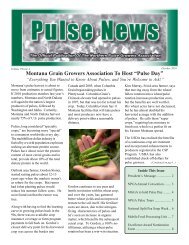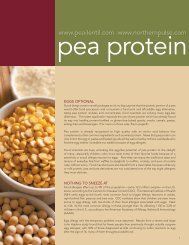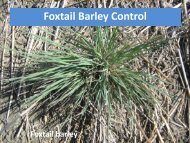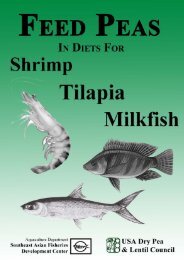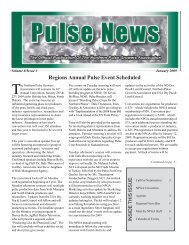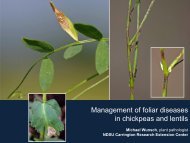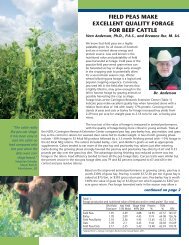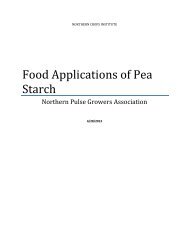2012 Disease Management Update by Michael Wunsch
2012 Disease Management Update by Michael Wunsch
2012 Disease Management Update by Michael Wunsch
You also want an ePaper? Increase the reach of your titles
YUMPU automatically turns print PDFs into web optimized ePapers that Google loves.
<strong>Disease</strong> management update -<br />
lentils, chickpeas, and field peas<br />
<strong>Michael</strong> <strong>Wunsch</strong>, PhD<br />
plant pathologist<br />
NDSU Carrington Research Extension Center
Ascochyta blight<br />
Caused <strong>by</strong> the fungal pathogen<br />
Ascochyta rabiei<br />
CHICKPEAS
CHICKPEAS<br />
Ascochyta blight – management<br />
Use clean seed:<br />
• Ascochyta blight is seed-borne and seed-transmitted.<br />
• Seed should be tested for Ascochyta. Only use seed with 0% or < 0.3% incidence<br />
of Ascochyta.<br />
Always treat seed with thiabendazole (Mertect).<br />
• Even if seed test indicates 0% Ascochyta infection
CHICKPEAS<br />
Ascochyta blight – management<br />
Make timely fungicide applications:<br />
• Apply preventatively; cannot eradicate Ascochyta blight once it has developed.<br />
• First application – 7 to 10 days before bloom (if wet), bloom initiation (if dry).<br />
• One or more applications may be necessary during pod-fill<br />
- <strong>Disease</strong>d pods often fail to produce seed<br />
- Even low levels of foliar disease during bloom can lead to high levels of pod infections
CHICKPEAS<br />
Ascochyta blight – management<br />
Fungicide resistance management is critical:<br />
• When canopy is open, tank-mix with chlorothalonil (Bravo WS, Echo 720, etc.)<br />
• Rotate Proline (DMI fungicide, FRAC 3) with a carboxamide (FRAC 7):<br />
Endura (boscalid)<br />
Priaxor (pyraclostrobin + fluxapyroxad)<br />
Vertisan (penthiopyrad)<br />
Note that ProPulse is a premix of Proline and a carboxamide: If you apply Priaxor<br />
or Vertisan after ProPulse, you will not be rotating fungicide chemistries.
CHICKPEAS<br />
Fungicide efficacy:<br />
Endura<br />
CARRINGTON 2011:<br />
Chickpea cultivar: Xena<br />
Planting date: May 25<br />
Fungicide timing:<br />
A = June 23, B = July 6, C = July 18, D = July 29<br />
MINOT 2011:<br />
Chickpea cultivar: Xena<br />
Planting date: May 19<br />
Fungicide timing:<br />
A = July 2, B = July 15, C = July 29, D = Aug. 12<br />
Carrington<br />
(2011)<br />
Minot<br />
(2011)
Fungicide efficacy:<br />
Endura<br />
CHICKPEAS<br />
CARRINGTON 2009:<br />
Chickpea cultivar: Sierra<br />
Planting date: May 22<br />
Fungicide timing, Carrington:<br />
A = June 30, B = July 13, C = July 28<br />
Carr. 2011 Minot 2011 Carrington 2009
CHICKPEAS<br />
Fungicide efficacy: Vertisan<br />
CARRINGTON 2011:<br />
Chickpea cultivar: Xena<br />
Planting date: May 25<br />
Fungicide timing:<br />
A = June 23, B = July 6, C = July 18<br />
Carrington 2011 Williston 2011<br />
WILLISTON 2011:<br />
Chickpea cultivar: Dylan<br />
Planting date: May 26<br />
Fungicide timing:<br />
A = June 28, B = July 7, C = July 21
Fungicide efficacy: Priaxor<br />
CHICKPEAS<br />
CARRINGTON 2011:<br />
Chickpea cultivar: Xena<br />
Planting date: May 25<br />
Fungicide timing: A = June 23, B = July 6, C = July 18, D = July 29, E = Aug. 10
LENTILS<br />
There are five major foliar disease of lentils in ND<br />
ANTHRACNOSE – caused <strong>by</strong> Colletotrichum truncatum<br />
ASCOCHYTA – caused <strong>by</strong> Ascochyta lentis<br />
BOTRYTIS GRAY MOLD – caused <strong>by</strong> Botrytis cinerea and B. fabae<br />
SCLEROTINIA STEM ROT (WHITE MOLD) – Sclerotinia sclerotiorum<br />
STEMPHYLIUM BLIGHT – caused <strong>by</strong> Stemphylium botryosum
Lentil anthracnose<br />
Foliar lesions: A<br />
Stem lesions: B<br />
Much more<br />
damaging than<br />
Ascochyta.<br />
LENTILS
Lentil anthracnose<br />
LENTILS<br />
• Lesions girdle stems, killing plants<br />
• Causes dead spots within fields<br />
• Infected seeds are discolored
LENTILS<br />
Lentil anthracnose - distribution<br />
Widespread in northwest, west-central, and east-central North Dakota<br />
2011 survey: WILLIAMS COUNTY – 11 of 13 fields<br />
MOUNTRAIL, McLEAN, and WARD COUNTIES – 5 of 9 fields<br />
FOSTER and SHERIDAN COUNTIES – 2 of 2 fields
Anthracnose -<br />
Partial host resistance<br />
LENTILS
LENTILS<br />
Lentil anthracnose – partial host resistance
LENTILS<br />
Anthracnose – fungicide efficacy<br />
Fungicide timing:<br />
A = 3 to 4 days after bloom initiation (June 28)<br />
B = July 9<br />
Location: Carrington, ND<br />
Seeding date: May 3, 2010<br />
Variety: Pennel
Anthracnose<br />
Fungicide timing:<br />
A = Bloom initiation (June 30)<br />
B = Canopy closure (July 11)<br />
C = July 13, D = July 20, E = July 27<br />
ANTHRACNOSE SEVERITY RATING SCALE:<br />
0 = no disease<br />
1 = incidence low; infected plants generally have 1 lesion/stem<br />
2 = incidence low; infected plants generally have 2 lesions/stem<br />
LENTILS<br />
Location: Carrington, ND<br />
Variety: CDC Maxim CL<br />
Planting date: May 17, 2011<br />
3 = incidence moderate; infected plants have 2 to 3 lesions/stem<br />
4 = incidence moderate to high; infected plants have ≥4 lesions/stem<br />
5 = incidence severe; plant mortality high
Ascochyta blight<br />
Easily confused with anthracnose.<br />
Anthracnose: A,C<br />
Ascochyta: B,D,E<br />
E<br />
LENTILS
Ascochyta blight<br />
LENTILS<br />
Widespread but generally well managed.<br />
In 2011, at trace levels in all regions surveyed except northeastern Montana.
Ascochyta blight<br />
Small green lentils:<br />
CDC Viceroy – good resistance<br />
Medium green lentils:<br />
CDC Improve CL – fair resistance<br />
CDC Greenland – good resistance<br />
CDC Meteor – good resistance<br />
CDC Richlea – very poor resistance<br />
Extra small red lentils:<br />
CDC Impala CL – good resistance<br />
CDC Rosetown – good resistance<br />
Small red lentils:<br />
CDC Maxim CL – good resistance<br />
CDC Redberry – good resistance<br />
CDC Red Rider– good resistance<br />
CDC Rouleau– good resistance<br />
LENTILS<br />
SOURCE: Saskatchewan Ministry of Agriculture “Varieties of Grain Crops 2011”
Ascochyta blight<br />
LENTILS<br />
Fungicide efficacy: no data available<br />
• Other crops: Headline, Priaxor, and Proline effective<br />
Fungicide timing: bloom initiation or canopy closure
Botrytis<br />
LENTILS<br />
Distinctive sporulation<br />
found in early morning<br />
and/or after rains until<br />
disease kills plant.
Botrytis gray mold<br />
LENTILS<br />
At a field level, symptoms are very similar to Sclerotinia:<br />
Initially, chlorosis of upper leaves<br />
Later, necrosis
LENTILS<br />
Botrytis gray mold - distribution<br />
A severe problem in west-central ND in 2011.
Fungicide timing:<br />
A = Pre-bloom/bloom initiation, canopy open (July 1)<br />
B = Mid-bloom, canopy closure (July 11)<br />
C = End of bloom (July 15)<br />
D = Early pod set (July 29)<br />
LENTILS<br />
Botrytis gray mold - management<br />
Location: Minot, ND<br />
Variety: CDC Richlea<br />
Planting date: May 19, 2011
LENTILS<br />
Botrytis gray mold - management<br />
Relative susceptibility of commercial lentil varieties: unknown<br />
Fungicide efficacy: no data available<br />
• Other crops: Headline and Endura are effective<br />
• very high-risk for the development of fungicide resistance<br />
Fungicide timing: canopy closure<br />
Seed-borne: Do not save seed from an infested field.
LENTILS<br />
Sclerotinia stem rot (white mold)
LENTILS<br />
Sclerotinia stem rot (white mold)<br />
At a field level, symptoms are very similar to Botrytis:<br />
Initially, chlorosis of upper leaves<br />
Later, necrosis
LENTILS<br />
Sclerotinia stem rot (white mold): distribution<br />
Widespread in central and west-central ND.<br />
In northwestern ND, a problem in acreage with irrigation capabilities<br />
(including fields that were not irrigated this season).
LENTILS<br />
Sclerotinia stem rot (white mold): management<br />
Relative susceptibility of commercial lentil varieties: unknown<br />
Fungicide efficacy: no data available for lentils<br />
• Other crops: Endura and Proline are effective<br />
Fungicide timing: canopy closure
Stemphylium blight<br />
LENTILS<br />
A problem when rains occur at mid- to late-bloom
Stemphylium blight<br />
LENTILS
Stemphylium blight<br />
LENTILS
Stemphylium blight<br />
Widespread<br />
LENTILS<br />
Only a problem where late rains occurred while lentils in pod-fill stage.
LENTILS<br />
Stemphylium blight<br />
Lentil varieties<br />
differ in susceptibility<br />
F: 15.63,<br />
P > F: < 0.0001<br />
CV: 63.05<br />
Lentil variety trial, Hettinger, ND (August 1, 2011):
Stemphylium blight<br />
Susceptibility, Clearfield lentils:<br />
<strong>Disease</strong> ratings taken<br />
August 21<br />
Clearfield lentil variety trial, Minot, ND (August 21, 2011):<br />
LENTILS
Stemphylium blight<br />
Common fungicide strategies<br />
(products and/or application timing)<br />
may not be effective.<br />
Location: Buchanan, ND<br />
Variety: CDC Impala<br />
Fungicide timing:<br />
A = Three days prior to bloom initiation (June 30)<br />
B = Full bloom (July 11)<br />
C = Full bloom (July 20)<br />
D = July 20, E = July 24<br />
LENTILS
Mycosphaerella blight<br />
FIELD PEAS<br />
Caused <strong>by</strong> three fungal pathogens:<br />
Ascochyta pinodes (Mycosphaerella pinodes)<br />
Ascochyta pisi<br />
Phoma medicaginis var. pinodella
Fungicide efficacy –<br />
Mycosphaerella blight<br />
FIELD PEAS
Fungicide efficacy –<br />
Mycosphaerella blight<br />
FIELD PEAS
Fungicide efficacy –<br />
Mycosphaerella blight<br />
FIELD PEAS
Thank you!




